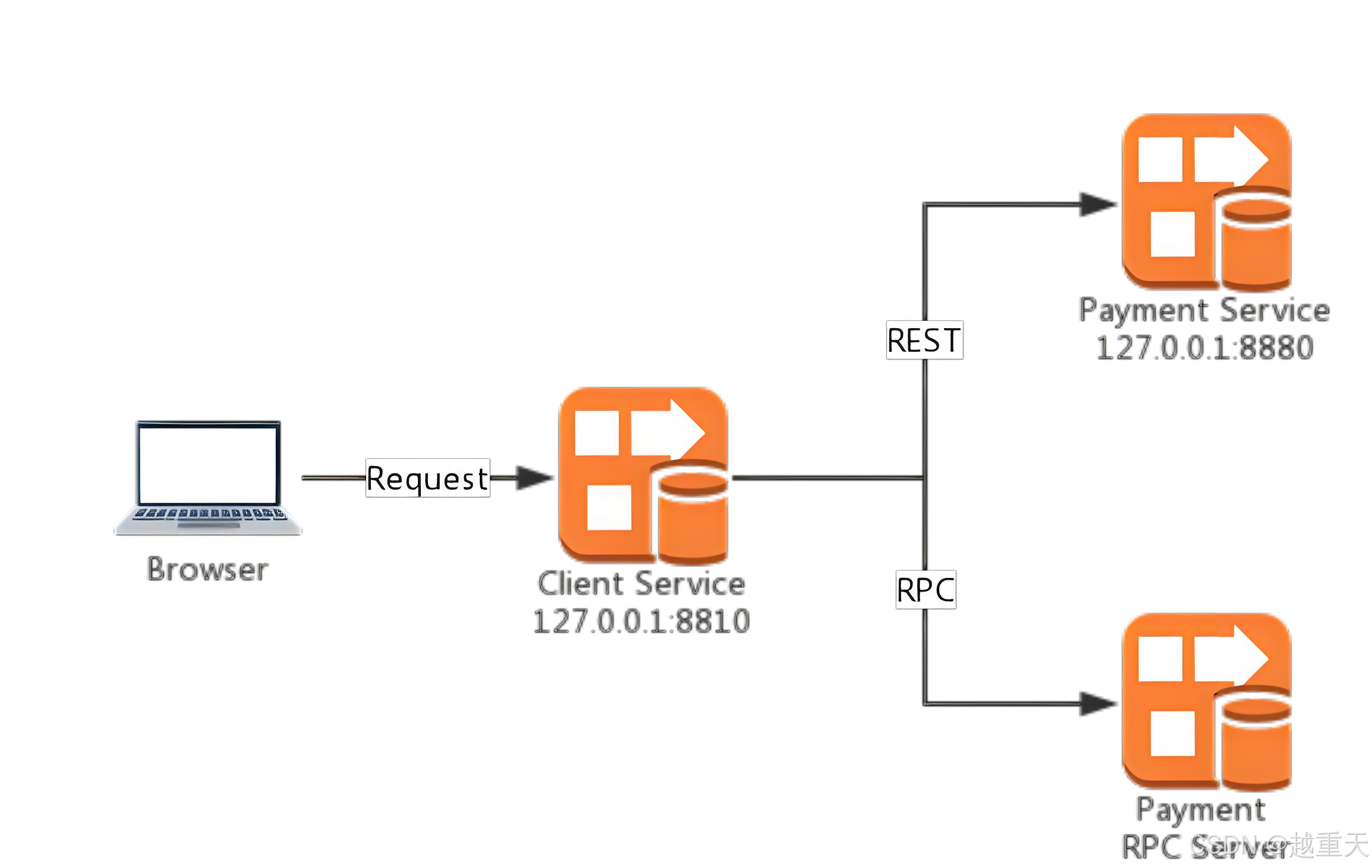微服务远程调用完全透传实现:响应式与非响应式解决方案
🧑 博主简介:CSDN博客专家,历代文学网(PC端可以访问:https://literature.sinhy.com/#/?__c=1000,移动端可微信小程序搜索“历代文学”)总架构师,
15年工作经验,精通Java编程,高并发设计,Springboot和微服务,熟悉Linux,ESXI虚拟化以及云原生Docker和K8s,热衷于探索科技的边界,并将理论知识转化为实际应用。保持对新技术的好奇心,乐于分享所学,希望通过我的实践经历和见解,启发他人的创新思维。在这里,我希望能与志同道合的朋友交流探讨,共同进步,一起在技术的世界里不断学习成长。
技术合作请加本人wx(注明来自csdn):foreast_sea


微服务远程调用完全透传实现:响应式与非响应式解决方案
本文将深入探讨如何实现远程调用的完全透传机制,确保微服务间的错误响应(包括状态码、头部和正文)能原样返回给客户端。涵盖响应式(WebClient)和非响应式(RestClient)两种实现方案。
一、核心挑战:为何需要完全透传?
在微服务架构中,服务间通信常面临以下痛点:
- 错误信息丢失:客户端库(如
WebClient/RestClient)默认将4xx/5xx响应转换为异常 - 响应不一致:网关层无法获取下游服务的原始错误详情
- 调试困难:生产环境难以定位根因问题
透传的核心要求:
- 保留原始HTTP状态码(如404、503等)
- 透传所有响应头(
Content-Type、X-Request-ID等) - 完整传递响应体(
JSON/XML/二进制等) - 支持大文件流式传输
二、响应式实现方案(WebClient)
1. 关键配置:禁用默认错误处理
@Bean@LoadBalancedpublic WebClient.Builder loadBalancedWebClientBuilder() { return WebClient.builder() .clientConnector(new ReactorClientHttpConnector(createHttpClient()));}private HttpClient createHttpClient() { return HttpClient.create() .responseTimeout(Duration.ofSeconds(10)) .option(ChannelOption.CONNECT_TIMEOUT_MILLIS, 3000);}2. 声明式接口设计
@HttpExchange(url = \"/api/service\")public interface RemoteService { // 使用ClientResponse接收原始响应 @GetExchange(\"/resource\") Mono<ClientResponse> getResource();}3. 控制器透传实现
@GetMapping(\"/proxy\")public Mono<ResponseEntity<byte[]>> proxy() { return remoteService.getResource() .flatMap(clientResponse -> clientResponse.bodyToMono(ByteArrayResource.class) .map(body -> ResponseEntity.status(clientResponse.statusCode()) .headers(clientResponse.headers().asHttpHeaders()) .body(body.getByteArray()) );}4. 大文件流式传输
@GetExchange(value = \"/large-file\", accept = \"application/octet-stream\")Mono<ClientResponse> getLargeFile();@GetMapping(\"/proxy-large\")public Mono<ResponseEntity<Flux<DataBuffer>>> proxyLargeFile() { return remoteService.getLargeFile() .map(clientResponse -> ResponseEntity.status(clientResponse.statusCode()) .headers(clientResponse.headers().asHttpHeaders()) .body(clientResponse.body(BodyExtractors.toDataBuffers())));}5. 性能优化配置
private ConnectionProvider connectionProvider() { return ConnectionProvider.builder(\"lb-pool\") .maxConnections(200) .pendingAcquireTimeout(Duration.ofSeconds(30)) .maxIdleTime(Duration.ofSeconds(60)) .build();}三、非响应式实现方案(RestClient)
1. 核心配置:自定义错误处理器
@Bean@LoadBalancedpublic RestClient.Builder loadBalancedRestClientBuilder() { return RestClient.builder() .requestFactory(() -> new HttpComponentsClientHttpRequestFactory(httpClient()));}2. 声明式接口设计
@HttpExchange(url = \"/api/service\")public interface RemoteService { // 使用字节数组接收原始响应体 @GetExchange(\"/resource\") ResponseEntity<byte[]> getResource();}3. 控制器透传实现
@GetMapping(\"/proxy\")public ResponseEntity<byte[]> proxy() { ResponseEntity<byte[]> response = remoteService.getResource(); return ResponseEntity.status(response.getStatusCode()) .headers(response.getHeaders()) .body(response.getBody());}4. 大文件流式传输
@GetExchange(value = \"/large-file\", accept = \"application/octet-stream\")ResponseEntity<InputStreamResource> getLargeFile();@GetMapping(\"/proxy-large\")public ResponseEntity<InputStreamResource> proxyLargeFile() { ResponseEntity<InputStreamResource> response = remoteService.getLargeFile(); return ResponseEntity.status(response.getStatusCode()) .headers(response.getHeaders()) .body(response.getBody());}5. 连接池优化配置
private PoolingHttpClientConnectionManager poolingConnManager() { PoolingHttpClientConnectionManager pool = new PoolingHttpClientConnectionManager(); pool.setMaxTotal(200); pool.setDefaultMaxPerRoute(50); return pool;}private CloseableHttpClient httpClient() { return HttpClients.custom() .setConnectionManager(poolingConnManager()) .setDefaultRequestConfig(RequestConfig.custom() .setConnectTimeout(Timeout.ofSeconds(5)) .setResponseTimeout(Timeout.ofSeconds(30)) .build()) .build();}四、通用增强功能
1. 请求头透传拦截器
public class HeaderPropagationInterceptor implements ClientHttpRequestInterceptor { @Override public ClientHttpResponse intercept(HttpRequest request, byte[] body, ClientHttpRequestExecution execution) throws IOException { // 从当前请求获取头信息 ServletRequestAttributes attributes = (ServletRequestAttributes) RequestContextHolder.currentRequestAttributes(); // 透传认证头 propagateHeader(request, attributes, \"Authorization\"); // 透传语言头 propagateHeader(request, attributes, HttpHeaders.ACCEPT_LANGUAGE); return execution.execute(request, body); } private void propagateHeader(HttpRequest request, ServletRequestAttributes attributes, String headerName) { String value = attributes.getRequest().getHeader(headerName); if (value != null) { request.getHeaders().add(headerName, value); } }}2. 负载均衡集成
@Configurationpublic class LoadBalancerConfig { @Bean public ServiceInstanceChooser loadBalancer(RestTemplate restTemplate) { return new RetryableServiceInstanceChooser( new LoadBalancerClient(restTemplate), 3, 1000 // 重试3次,间隔1秒 ); } @Bean @LoadBalanced public RestClient.Builder restClientBuilder() { return RestClient.builder(); }}3. 熔断降级机制
@CircuitBreaker(name = \"remoteService\", fallbackMethod = \"fallback\")public ResponseEntity<byte[]> getResource() { return remoteService.getResource();}private ResponseEntity<byte[]> fallback(Exception ex) { return ResponseEntity.status(HttpStatus.SERVICE_UNAVAILABLE) .body(\"{\\\"error\\\":\\\"Service unavailable\\\"}\".getBytes());}五、方案对比与选型建议
defaultStatusHandlerResponseErrorHandlerFluxInputStreamResource选型建议:
- 新建项目且需要高并发 → 选择WebClient
- 传统Spring MVC应用 → 选择RestClient
- 网关/代理服务 → 优先WebClient
六、常见问题解决方案
问题1:响应体已被消费
现象:IllegalStateException: Body has already been consumed
解决:
// WebClient.flatMap(clientResponse -> clientResponse.bodyToMono(ByteArrayResource.class) // 先读取为内存缓存)// RestClientResponseEntity<byte[]> response = remoteService.getResource(); // 自动处理问题2:负载均衡失效
检查:
- 确保使用
@LoadBalanced注解 - 检查服务发现配置(如Nacos、Consul)
- 验证服务名格式:
lb://service-name
问题3:头信息丢失
解决方案:
// 在拦截器中显式复制关键头信息request.getHeaders().addAll( ServletServerHttpRequest( attributes.getRequest()).getHeaders());七、结论
实现远程调用的完全透传需要解决三个关键问题:
- 禁用默认错误处理:通过
defaultStatusHandler(WebClient)或ResponseErrorHandler(RestClient) - 保留原始响应:使用
ClientResponse(WebClient)或ResponseEntity(RestClient) - 正确传输响应:控制器层1:1映射状态码、头部和正文
最佳实践建议:
- 中小响应(<10MB)使用字节数组
- 大文件使用流式传输
- 配置连接超时(<5s)和读取超时(<30s)
- 集成熔断机制(如Resilience4j)
通过本文提供的响应式和非响应式两套完整方案,开发者可轻松实现“透明管道”式远程调用,确保网关层能原样透传下游服务的所有响应,极大提升微服务架构的调试效率和用户体验。


